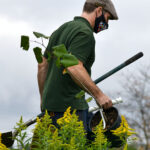
How To Support Declining Butterfly Populations In The Fall
- Thomas Nelson
- September 16, 2023
- Nature
- 0 Comments
Many insects, including butterflies, have been in decline over the years. Monarch butterflies in particular grabbed headlines after being listed as endangered. Fortunately, there are things that many of us can do to help these declining butterflies survive winter and thrive the following spring. Let’s dive in.
6 ways to support declining butterfly populations in the autumn
With butterfly populations in decline, in large part due to habitat loss, what we do with our yards and gardens is really important for preserving and saving these vital pollinators. Here are a few things you can do to help out butterflies in fall and winter.
Plant native, late-blooming flowers
Planting late-blooming flowers to support butterflies is a thoughtful and effective way to contribute to the conservation of these beautiful and essential pollinators. While many people think of spring and early summer as the prime time for planting flowers, late-blooming varieties have their own unique benefits for butterflies:
- Sustained Nectar Availability: Late-blooming flowers provide a crucial nectar source for butterflies in the late summer and early autumn when many other nectar-rich plants have already faded. This extended nectar supply helps butterflies fuel up for their long migrations or build up energy for hibernation.
- Butterfly Migration: Some butterfly species, like the Monarch butterfly, embark on long-distance migrations, traveling thousands of miles. Late-blooming flowers serve as essential refueling stations along their journey, ensuring they have the energy needed to complete their remarkable migrations successfully.
- Fall Breeding: Late-blooming flowers can attract adult butterflies for breeding and egg-laying. This helps support the next generation of butterflies as they have access to nectar and host plants during a critical period.
- Biodiversity: By planting a variety of late-blooming flowers, you can attract a diverse range of butterfly species. Different butterfly species have unique preferences for nectar sources, so a variety of late-blooming flowers can help support a diverse butterfly population.
- Garden Continuity: Late-blooming flowers can extend the beauty and vibrancy of your garden well into the fall season, providing you with colorful and visually appealing landscapes when other plants may be past their prime.
- Educational Opportunities: Planting late-blooming flowers to support butterflies can be an excellent educational tool, especially for children. It offers the chance to observe the life cycle of butterflies up close, from caterpillar to chrysalis to adult, fostering a deeper appreciation for the natural world.
When choosing late-blooming flowers for your garden, consider native plant species, as they are well-suited to the local environment and wildlife. Additionally, avoid the use of pesticides, as they can harm both butterflies and their host plants. By creating a butterfly-friendly garden with late-blooming flowers, you can make a positive impact on butterfly populations and enjoy the beauty of these graceful insects in your outdoor space.
Cut back on non-native flowers in your garden
Embracing native plant species in your garden while cutting back on non-native flowers is a crucial step in supporting butterfly populations and promoting a healthier ecosystem. Native plants have evolved alongside local wildlife, including butterflies, over millennia, resulting in a harmonious relationship that benefits both plants and insects. Native flora provides the specific nectar sources, host plants, and habitat that local butterflies need to thrive. These native plants have often developed unique adaptations to attract and sustain native butterfly species.
One of the key advantages of native plants is their role as host plants. Many butterfly species lay their eggs on particular host plants, and the caterpillars that hatch from these eggs rely exclusively on these host plants as their food source. Native plants frequently serve as host plants for local butterfly species, ensuring the survival and reproduction of the next generation. Non-native plants often lack these crucial associations, leaving butterflies with inadequate resources for their life cycles.
In addition to supporting the life cycles of butterflies, native plants offer the right nectar sources. Native species typically produce nectar that aligns with the feeding habits and preferences of local butterflies. Non-native plants may not provide the appropriate nectar type or may not bloom at the necessary times, leaving butterflies without a reliable food source.
Furthermore, the use of native plants in your garden contributes to biodiversity preservation. Native plants are inherently connected to the local ecosystem, providing habitat and sustenance to a wide range of wildlife, from insects and birds to other pollinators. By cultivating native species, you create a balanced and resilient environment that supports various forms of life, ultimately enhancing the overall health and diversity of your local ecosystem.
Planting native species is especially important for butterfly conservation. Many butterfly populations are dwindling due to habitat loss and other environmental pressures. By incorporating native plants into your garden, you are contributing to the preservation of these elegant insects by providing them with suitable habitats and ample food sources.
Leave your garden messy over the winter
Many of us like to clean up our gardens in the fall so we have an easy task ahead of us in spring. Leaving your garden messy over the winter can be a beneficial practice for supporting butterflies and other wildlife, though. While the instinct might be to tidy up the garden once the growing season ends, allowing certain areas to remain in a state of controlled chaos has several advantages.
Many butterfly species overwinter in various stages of their life cycle. Some butterflies spend the winter as caterpillars, pupae, or even as adults. These overwintering stages often find refuge in leaf litter, decaying plant matter, or the dead stems of perennials. By leaving these areas undisturbed, you provide crucial shelter for butterflies during the cold months. When spring arrives, these overwintering butterflies will emerge, ready to continue their life cycles and contribute to local pollination.
Leaving garden debris and plant remnants in place benefits other native insects, which, in turn, can indirectly support butterfly populations. Native bees, beneficial wasps, and other insects often overwinter in garden debris or hibernate in hollow stems. These insects serve as essential pollinators and contribute to the overall biodiversity of your garden.
In addition to benefiting wildlife, a messy garden in winter can also have advantages for your garden’s health. Plant debris and leaves left on the ground act as natural mulch, protecting soil from erosion and temperature fluctuations. As this organic matter decomposes, it enriches the soil, improving its fertility and structure, which can result in healthier plants come spring. So it’s not a bad choice for the health of your garden overall.
To maintain a garden that supports butterflies and other wildlife over the winter, consider some simple practices. Leave a portion of your garden beds unpruned, allowing stems and seed heads to stand through the winter. Leave leaf litter undisturbed in certain areas, as this provides insulation for overwintering insects and keeps the soil below more stable. Lastly, refrain from clearing away all garden debris; instead, selectively tidy up while leaving some spots untouched.
Leave the leaves
Many of us look to discard fallen leaves as soon as they hit the ground, with some places even sending them to the landfill in plastic bags! Leaving fallen leaves on the ground in the fall can be a simple yet effective practice to support butterflies and other wildlife. This practice is particularly beneficial for several reasons.
Many butterfly species spend the winter in various stages of their life cycle, such as caterpillars, chrysalises, or even as adult butterflies. Fallen leaves create a natural insulating layer, providing shelter and protection for these overwintering butterflies. By leaving the leaves undisturbed, you offer essential habitat for these insects during the cold months, helping them survive until the arrival of spring.
Fallen leaves also contribute to nutrient recycling and soil health. As leaves decompose, they return essential nutrients to the soil, improving its fertility and structure. Healthy soil, enriched by decomposing leaves, can support a diverse range of plants, including nectar-rich flowers that adult butterflies depend on for food.
Moreover, leaf litter on the ground creates microhabitats that benefit various insects, including beneficial pollinators like native bees and wasps. These insects play an important role in supporting butterfly populations indirectly by pollinating the plants that butterflies rely on for nectar.
Leave some fallen fruit on the ground
People like to have well-manicured, clean yards, but leaving fallen fruit on the ground in the fall can play a role in supporting butterflies and other wildlife. While it might not be a direct source of sustenance for adult butterflies, it can indirectly benefit them in several ways.
Some butterfly species, like the Red Admiral and the Eastern Comma, are known to feed on overripe or fermenting fruit as adults. By providing a source of fermenting fruit on the ground, you create a suitable environment for these butterflies to feed. This, in turn, can encourage these butterfly species to lay their eggs nearby, as the availability of adult food sources can influence their choice of oviposition sites.
Encouraging a diverse range of insects and wildlife in your garden creates a more balanced ecosystem. Biodiversity can enhance the overall health of your garden, making it a more attractive environment for various species of butterflies and other pollinators.
Fallen fruit eventually decomposes and contributes nutrients to the soil. As it breaks down, it enriches the soil with organic matter, benefiting the health of plants, including those that provide nectar and serve as host plants for butterflies.
It’s important to note that while leaving fallen fruit can have ecological benefits, it should be done in moderation. Excessive fruit on the ground can attract pests and may become a breeding ground for unwanted insects. To strike the right balance, consider allowing some fallen fruit to remain, especially in areas where it won’t create sanitation or pest issues, while cleaning up any excess fruit to maintain a healthy garden environment.
Create more natural spaces
At the end of the day, the best thing you can do to support butterflies and other insects and wildlife is to create natural spaces. Overgrown native grasses, dense shrubs, trees, rock piles, leaf piles – all of it contributes to the health and success of wild butterfly populations. You can have your well-manicured space for yourself, but consider dedicating some of your yard to rewilding efforts.

